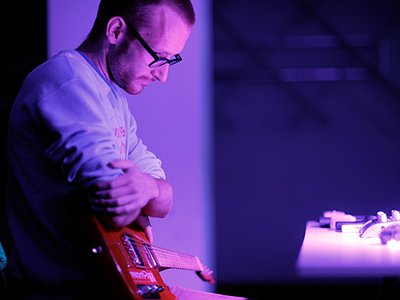Do you feel it important that an audience is able to deduct the processes and ideas behind a work purely on the basis of the music? If so, how do you make them transparent?
Good question. I’m not sure about this, because on one hand it should be about the music, not about the methods, but I also like it if things aren’t so mysterious.
When talking about ideas or concept behind a piece, I think it’s really important that the music can be listened and enjoyed on its own terms. There’s always an idea behind it, but I never get over-theoretical. It shouldn’t get in the way of the listening experience, and it definitely shouldn’t ruin the listeners’ imagination.
As for the process, when you by an album from me it might not always be clear how I made it and I don’t know how to change that, or if it’s important. But with a live performance, people can always see what I do. I don’t perform with a laptop, but with all kinds of electronic equipment and gadgets, it’s very hands on, so it’s very visual. You might not be able to exactly see what I’m doing, but at least you see a relation to the sound. Sometimes I get mixed reactions, some people find it distracting, others find it really interesting. I always suggest the possibility to close your eyes when listening, so you can choose how you want to experience it.
In how much, do you feel, are creative decisions shaped by cultural differences – and in how much, vice versa, is the perception of sound influenced by cultural differences?
Christ, that’s a difficult one. Of course there is a difference, if there wasn’t, everyone would be listening to and making the same music all over the world. I’m glad that’s not the case. But I’m not an expert on this.
The relationship between music and other forms of art – painting, video art and cinema most importantly - has become increasingly important. How do you see this relationship yourself and in how far, do you feel, does music relate to other senses than hearing alone?
More then any other medium, sounds speaks to our feelings in the most direct way. I think this is because we’re very visually oriented, so when using a medium without a visual component, it leaves so much more room for our imagination. But if the relationship between music and other forms of art became increasingly important society becomes more and more media-focused.
For me personally it’s hard to see a change in that relationship, simply because my relationship with it also changed in the past years. A few years back I didn’t have the same ideas about it as I do now, which makes it hard to compare. This has to do with the fact that I work with visual artists more and more. In my work there is more and more flirtation with the visual arts. I didn’t so much see them as things that should be combined, but now I do think that sound and vision can definitely be more than the sum of its parts when done right. Working with video and within fine art projects also opens doors to new ideas for making music or dealing with sound in a broader context.
There seem to be two fundamental tendencies in music today: On the one hand, a move towards complete virtualisation, where tracks and albums are merely released as digital files. And, on the other, an even closer union between music, artwork, packaging and physical presentation. Where do you stand between these poles?
Personally I go for the complete package of music and packaging. I design my own album sleeves, so they’re an important part of the music. It’s probably old fashioned, but a digital file just doesn’t feel like it has the same value as a physical product does. An album is complete when I can hold it in my hands, feel and smell the paper, hold the disc in my hands or see grooves in the vinyl. But I know it’s not like that for everyone, and that there are enough people that enjoy digital files and have the same passion for the music




